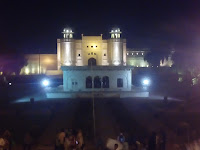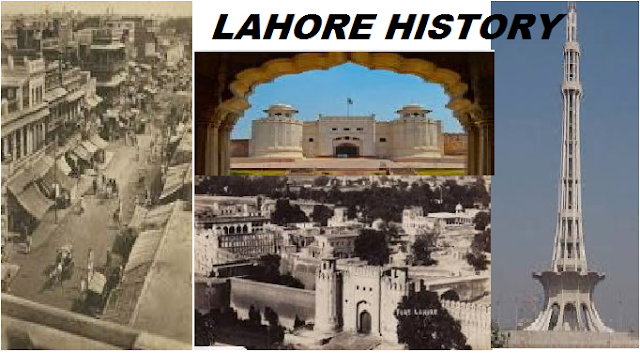LOH, LAVAPURI, AND LAHORE
Loh was a son of Rama(Hindu god) and Sita(Hindu goddess). According to a popular anecdote Sita (Hindu goddess) was pregnant when she has to left far in green plains of Punjab. She stayed in a small town at the bank of river Irravati or Parushni (old name of River Ravi) and gave birth to twin boys of Rama (Hindu god) in an Ashram. The princes named “Loh” and “Kusha” were set educated and trained to military expertise while young. Prince Kusha created a town which is known as “Kasur” nowadays and Prince Loh put the foundations of a small-town “LAVAPURI” at south banks of heavenly blue River Ravi that turned into a city of gardens Lahore. It is also said that Loh was the first to lay the foundation of Lahore fort as mud brick building amid wheat and Barley fields of Punjab. That’s why tourists and visitors can still spot a vacant place named as "TEMPLE OF LOH" in the Lahore fort.Though the city of Lahore doesn’t bear any authentic documented history details, the city dates back to 2000 BC. Lahore was a small town with fruit orchards, facilitated markets and gardens according to historians who mentioned the place in their expedition journals. A famous Egyptian astronomer Ptolemy and a Chinese pilgrim Xuanzang talked about a cultivated city on banks of River Ravi in their writings.
LAHORE FORT. Her soul is still roaming there.
RELIGIONS OF LAHORE
Jainism was the first practicing religion of the ancient natives of Lahore till the Hinduism made the space.Hinduism was practiced in the area for long and the city was almost cut from the rest of world developments till the Muslim invaders crossed the guarded barriers of Ravi River to capture the city in the 11th century. The arrival of Muslim rulers took Lahore to its new landmark position and set it to meet the modern world of time. Amid 17th and 18th century Sikhism was also practiced in Lahore until the Partition of 1947.
ALSO click to READ:
 |
How British killed last 3 Mughal Prince |
MAHMOOD GHAZNAVI AND MALIK AYAZ IN LAHORE
Mahmood of Ghaznavi invaded and captured Lahore in the year 1096. Mahmood Ghaznavi appointed his brave slave Malik Ayaz as a governor of the city and honored the city as his second capital after Ghazni. He also built the first garrison in the city. Ayaz was the first ruler who not only owned the city but made it appear significant on the world map. Malik Ayaz fabricated arts, poetry, and architecture in the city. He put the foundations of Lahore fort or Shahi Qila back at its position and Lahore Fort became the residence of upcoming great rulers. Lahore became the center of attraction of many invaders from the west as it was at the core of Sindh and Northern Punjab.MONGOLS AND LODHIS IN LAHORE
This city now has to pay for his limelight and Mongols hit and ruined the city in the 13th century. One can say that Lahore too was not safe from Mongol’s brutal violence like many other big cities of the world. Afterward there stuck a tug of war to hold the city between local and foreign invaders. Khiljis, Tughlaqs, Lodhis and Suri’s ruled the Lahore in 14th and early 15th century until Babur invaded the city and laid the foundations of great Mughal sultanate. Oh, we forget to mention the landmark of the city of Lahore “Lahore fort”… Lahore fort continued to serve as a resident castle and got extended with every ruler, but still, it was a mud brick building.LAHORE AND MUGHAL EMPERORS
Lahore was the capital of the great Mughal Empire in the time of Emperor Akbar until he shifted it to Fatehpur Sikri. Akbar rebuilt Lahore fort marking the significant architecture ecstasy of Mughals. Babur, Akbar, Jahangir, Shahjahan, and Aurangzeb visited Lahore many times and a great walled city of Lahore was developed with 8 gates in 300 years long Mughal era. Mughal King Jahangir and his favorite consort are buried in Lahore. Aurangzeb came here when Mughal was ruling from Bengal to Kabul and ordered to build Badshahi Mosque adjacent to Lahore Fort. Lahore was a mixture of Hindus, Muslims and Sikh natives at the time of Mughals. History keeps on changing the pages from its book and takes the readers to its new chapter. The Mughal had to see the collapse after 300 years of rule and Lahore fell to Sikhs' lap.
SIKH RULE IN LAHORE
Sikh rule started in the late 18th century after defeating the feeble Mughal forces when the head of Wazir Khan was held on a spear for long. Maharaja Ranjit Singh made Lahore it's capital and extended his territory till Kashmir. Huzoori Bagh Baradari in Hazoori Bagh was built by Ranjit Singh. Visitors can visit the Samadhi of Emperor Ranjit Singh while entering the Lahore fort and grave of Dalip Singh (son of Ranjit Singh) as a sign of almost 80 years influential Sikh rule in Lahore.BRITISH RULE IN LAHORE
By 1850 Lahore was annexed to the British government and remained under British rule for about a century. British government extended the city out of its walls and built Mall road and modern colonies with wide roads. British constructed colleges and universities and once again connected Lahore with the up-to-the-minute world.
LAHORE AND FREEDOM MOVEMENT OF PAKISTAN
How much beautiful it would be but slavery is a curse. British didn’t have an idea that soon Lahore will become the hub of freedom movement of Hindustan. The freedom movement from the British grasped a momentum when Quaid e Azam Muhammad Ali Jinnah passed Pakistan resolution amid public meeting on 23rd March 1940, in the wide ground adjacent to Lahore fort. British had to leave India and a new country Pakistan appeared on the map of the world. Now Lahore is the capital of Punjab province in Pakistan and a hub of cultural activities with having a lot of historical buildings in its center. These famous sayings can describe Lahore the best as the local say;- JINNAY LAHORE NHI TAKYA OO JAMIA NHI
(THE WHO DOESN’T SPOT LAHORE YET, HE’S NOT BORN YET)
AND
- LAHORE LAHORE HAI
(NOTHING IS LIKE LAHORE)
SEVEN DAYS AND EIGHT FAIRS IN LAHORE, I DON’T HAVE TIME TO GO BACK

